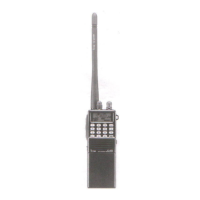SECTION 3 CIRCUIT DESCRIPTION
3-1 RECEIVER CIRCUITS
3-1-1 ANTENNA SWITCHING CIRCUIT (RF UNIT)
The antenna switching circuit functions as a low-pass fi lter
while receiving and a resonator circuit while transmitting.
The circuit does not allow transmit signals to enter receiver
circuits.
Received signals enter the RF unit from the antenna
connector (J3001), and then pass through the low-pass fi lter
(L4001–L4003, C4001–C4005) to suppress out-of-band
signals. The fi ltered signals are passed through the
λ
/
4
type
antenna switching circuit (D4001–D4003) with a low-pass
fi lter (L4004, L4005), and are then applied to the RF circuit.
3-1-2 RF CIRCUIT (RF UNIT)
The signals from the antenna switching circuit are passed
through the tunable bandpass fi lter (D4006, D4007, L4008,
L4009) and amplified at the RF amplifier (Q4001). The
amplified signals are passed through the bandpass filter
(D4008, D4009, L4010, L4011) again, and applied to the 1st
mixer circuit.
D4006–D4009 are varactor diodes and are controlled by the
PLL lock voltage. The voltage is buffer-amplified at Q4018
and is then applied to the varactor diodes. These varactor
diodes tune the center frequency of an RF passband
for wide bandwidth receiving and good image response
rejection. For weather channel receiving, the tune voltage
control circuit (Q4017, Q4019) supplies the bias voltage.
3-1-3 1ST MIXER AND 1ST IF CIRCUITS (RF UNIT)
The signals from the bandpass fi lter are mixed with a 1st LO
signal from the VCO board, and are converted to a 35.8 MHz
1st IF signal. The 1st IF signal is applied to a pair of crystal
fi lters (FI4001) to suppress out-of-band signals, and is then
amplifi ed at the 1st IF amplifi er (Q4003).
3-1-4 2ND MIXER AND 2ND IF CIRCUITS (MAIN UNIT)
The 2nd mixer circuit converts the 1st IF signal to a 2nd
IF signal. A double-conversion superheterodyne system
improves the image rejection ratio and obtains stable
receiver gain.
The 1st IF signal from the RF unit is applied to a 2nd mixer
section of IC5001 (pin 16). The signal is then mixed with a
2nd LO signal for conversion to a 455 kHz 2nd IF signal.
IC5001 contains the 2nd mixer, local oscillator, limiter
amplifi er and quadrature detector. The local oscillator section
generates 35.345 MHz using X5001.
The 2nd IF signal from the 2nd mixer (IC5001, pin 3) passes
through the ceramic filter (FI5001) to remove unwanted
heterodyned frequencies. It is then amplified at the 2nd IF
amplifi er (Q5002).
3-1-5 AM DETECTOR CIRCUIT (MAIN UNIT)
The AM detector circuit demodulates an AM signal on the
communication band or navigation band.
The 2nd IF signal from Q5002 is amplifi ed at IF amplifi ers
(Q5003, Q5030) again, and applied to the AM detector
(Q5004). It is then detected for conversion to an AF signal.
3-1-6 FM DETECTOR CIRCUIT (MAIN UNIT)
The FM detector circuit demodulates an FM signal for
weather channel receiving.
When receiving a weather channel, the 2nd IF signal from
Q5002 is applied to the limiter amplifier section (IC5001,
pin 5). To demodulate into AF signals, the 2nd IF signal is
then applied to the quadrature detector section (IC5001,
pins 10, 11) and the discriminator (X5002). The AF signal
(detector signal) is output from the FM IF IC (IC5001, pin 9).
3-1-7 SQUELCH CIRCUIT (MAIN UNIT)
The squelch circuit cuts out AF signals when no RF signal is
received.
A portion of the 2nd IF signal (from Q5002) is applied to
the limiter amplifier section (IC5001, pin 5). Then the FM
IF IC (IC5001) outputs a detected (IF level) signal from pin
12. This signal is applied to the comparator (IC5007), and
is then compared with preset squelch voltage. Output from
the comparator is applied to the AF selector (IC5002) as an
"SQL" signal, and controls the AF signal line.
3 - 1
• BLOCK DIAGRAM OF RECEIVER CIRCUIT IN THE RF UNIT
IF amp.
Q4003
From AGC From VCO
through
TX/RX switch
From
BPF control
From
RF-AGC
To MAIN unit
IC5001 pin 16
RF amp.
Q4001
1st mixer
Q4002
1st IF
filter
Antenna
switch
BPF
FI4001
LPF
D4001–D4003
D4008,
D4009
D4006,
D4007
[ANT]
BPF

